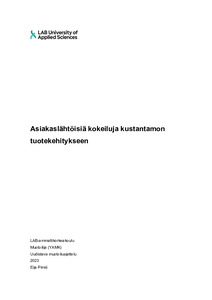Asiakaslähtöisiä kokeiluja kustantamon tuotekehitykseen
Pimiä, Eija (2023)
Pimiä, Eija
2023
All rights reserved. This publication is copyrighted. You may download, display and print it for Your own personal use. Commercial use is prohibited.
Julkaisun pysyvä osoite on
https://urn.fi/URN:NBN:fi:amk-202302112285
https://urn.fi/URN:NBN:fi:amk-202302112285
Tiivistelmä
Opinnäytetyön tavoitteena oli tuottaa asiakaslähtöisen suunnittelutietoa kustantamossa toimivan, puuhatuotteita toteuttavan tiimin tuotekehitystyöhön. Opinnäytetyö pyrki vastaamaan seuraaviin kysymyksiin: Onko asiakaslähtöistä suunnittelutietoa mahdollista hyödyntää kustantamon tuotekehityksessä? Toimivatko muotoiluajattelulle tyypilliset menetelmät tässä toimintaympäristössä?
Kehittämisprojektissa kokeiltiin muotoiluajattelulle tyypillisiä, osallistavia menetelmiä ja arvioitiin saadun tiedon sekä kokeiltavien menetelmien hyödyllisyyttä. Kokeilut toteutettiin noin kolmen kuukauden aikana keväällä 2022 kirjakaupassa ja kustantamossa. Kokeilut kohdistuivat tuotekehitysprosessin alkuvaiheisiin: asiakasymmärrykseen, ideointiin ja konseptointiin sekä testaukseen. Menetelmien valinnassa ja kokeilujen toteutuksessa pyrittiin valitsemaan mahdollisimman kevyet, kustannustehokkaat vaihtoehdot.
Kolmen kokeilun tuloksena saatiin 1) asiakasymmärrystä, jota voitiin hyödyntää uusien tuotteiden ideoinnin lähteenä, 2) muistikirjakäyttäjien yhteissuunnittelutilaisuudessa suunnittelemia uusia muistikirjatuotteita tuotantoon sekä 3) tietoa testattavan tuotteen käyttäjistä, kirjan ulkoasun toimivuudesta sekä ideoita tuotteen markkinointiin. The objective of the thesis was to produce customer insight for the product development. Product development focused on art and craft product category in a Finnish publishing company. Thesis aimed to answer the following questions: Can customer insight be utilized in a publishing company's product development? Are the typical design thinking methods applicable in this operating environment?
In the experimental development project, participatory methods typical for design thinking were tested, and the usefulness of the knowledge gained and the methods were assessed. The experiments were carried out over a period of about three months in a bookstore and publishing house in spring 2022. The experiments focused on the early stages of the product development process: customer insight, ideation and concept development, and testing. The aim was to select the most light and cost-effective methods as possible.
As a result of three experiments 1) customer understanding, which could be utilized as a source of ideas for new products, was obtained; 2) new notebook products designed by users in a co-design session were produced; and 3) Information about the users of the tested product, the functionality of the book's layout, and ideas for marketing the product were produced.
Kehittämisprojektissa kokeiltiin muotoiluajattelulle tyypillisiä, osallistavia menetelmiä ja arvioitiin saadun tiedon sekä kokeiltavien menetelmien hyödyllisyyttä. Kokeilut toteutettiin noin kolmen kuukauden aikana keväällä 2022 kirjakaupassa ja kustantamossa. Kokeilut kohdistuivat tuotekehitysprosessin alkuvaiheisiin: asiakasymmärrykseen, ideointiin ja konseptointiin sekä testaukseen. Menetelmien valinnassa ja kokeilujen toteutuksessa pyrittiin valitsemaan mahdollisimman kevyet, kustannustehokkaat vaihtoehdot.
Kolmen kokeilun tuloksena saatiin 1) asiakasymmärrystä, jota voitiin hyödyntää uusien tuotteiden ideoinnin lähteenä, 2) muistikirjakäyttäjien yhteissuunnittelutilaisuudessa suunnittelemia uusia muistikirjatuotteita tuotantoon sekä 3) tietoa testattavan tuotteen käyttäjistä, kirjan ulkoasun toimivuudesta sekä ideoita tuotteen markkinointiin.
In the experimental development project, participatory methods typical for design thinking were tested, and the usefulness of the knowledge gained and the methods were assessed. The experiments were carried out over a period of about three months in a bookstore and publishing house in spring 2022. The experiments focused on the early stages of the product development process: customer insight, ideation and concept development, and testing. The aim was to select the most light and cost-effective methods as possible.
As a result of three experiments 1) customer understanding, which could be utilized as a source of ideas for new products, was obtained; 2) new notebook products designed by users in a co-design session were produced; and 3) Information about the users of the tested product, the functionality of the book's layout, and ideas for marketing the product were produced.
